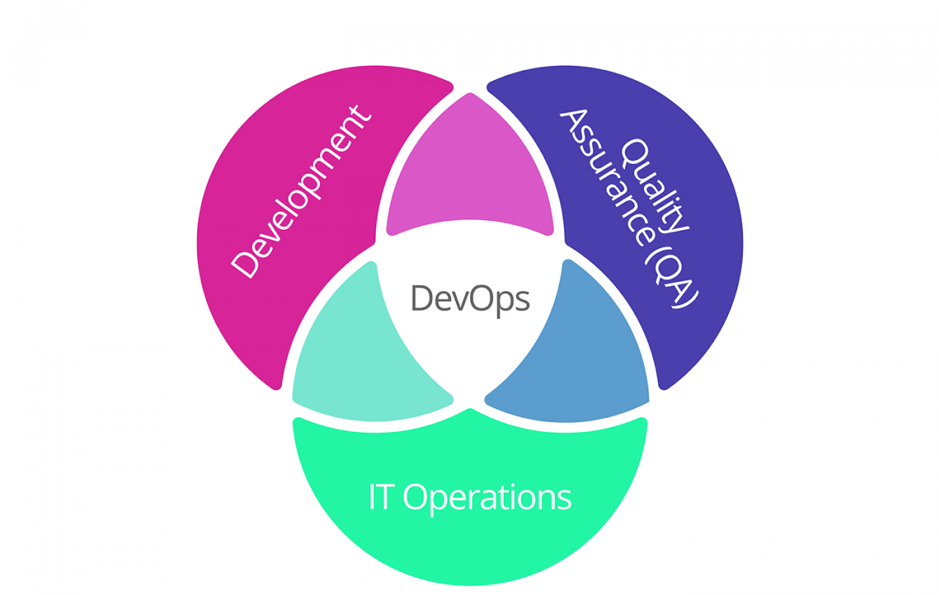Introduction:
In the world of software development, speed, agility, and efficiency are key to success. And that’s where DevOps comes in. DevOps is a set of practices that combines development and operations to automate and streamline the software development lifecycle. In this blog, we’ll explore the benefits of DevOps in software development and how it can help teams achieve their goals.
What is DevOps and how it works in software development?
DevOps is a set of practices that combines software development (Dev) and information technology operations (Ops) to create a continuous and automated software delivery pipeline. DevOps helps to speed up the software development process by streamlining collaboration between development and operations teams.
Traditionally, the development and operations teams worked in silos, leading to long and error-prone software delivery processes. DevOps, on the other hand, encourages teams to work together and share responsibilities for developing, deploying, and maintaining software applications.
The DevOps workflow consists of several stages, including planning, coding, building, testing, and deployment. During the planning phase, the team decides on the features, timelines, and resources required for the project. In the coding phase, developers write and review the code, and collaborate with other teams such as quality assurance and security.
Next, in the building phase, the code is compiled and built into a deployable package. In the testing phase, the code is tested for quality and compatibility, and feedback is provided to developers for further improvements. Finally, in the deployment phase, the software is released to production, and the team continues to monitor and maintain the application.
The key benefits of DevOps include improved collaboration, faster time-to-market, increased software quality, and reduced operational costs. By automating repetitive tasks, such as testing and deployment, DevOps enables teams to focus on innovation and delivering value to customers.
How DevOps can improve collaboration and communication between development and operations teams?
DevOps is not just about combining development and operations; it’s also about fostering a culture of collaboration, communication, and shared ownership. The traditional silos that separate development and operations teams can lead to inefficiencies, misunderstandings, and conflicts. DevOps helps to break down these barriers and create a more agile and cohesive team.
One of the key ways that DevOps improves collaboration is by encouraging frequent and open communication. In a DevOps environment, development and operations teams work together from the early stages of the software development lifecycle. This means that they have more opportunities to share ideas, identify problems, and work together to find solutions. By involving operations early in the process, developers can gain a better understanding of the infrastructure and operational requirements for the software they are building, which can help to avoid last-minute surprises.
Another way that DevOps improves collaboration is through the use of shared tools and processes. By standardizing processes and using common tools, teams can work more effectively together. For example, the use of a common version control system, such as Git, can enable teams to share code more easily and avoid conflicts. Similarly, the use of common testing frameworks and automated testing tools can ensure that both developers and operations are working towards the same goals.
Finally, DevOps improves collaboration by fostering a culture of shared ownership. In a DevOps environment, everyone is responsible for the success of the software, from development to operations. This means that developers take more responsibility for the quality of their code, and operations take more responsibility for ensuring that the software runs smoothly in production. By sharing ownership, teams can work more closely together and avoid the finger-pointing that often occurs in traditional siloed environments.
How DevOps can increase the speed of software development without sacrificing quality?
DevOps is all about speed and agility, but not at the cost of quality. One of the primary benefits of DevOps is that it can help to increase the speed of software development without sacrificing quality. By using a combination of automated tools and streamlined processes, teams can deliver software more quickly and with fewer defects.
One of the key tools in the DevOps toolbox is continuous integration (CI). CI is a process of automatically building, testing, and integrating code changes into the main codebase. By automating this process, developers can catch and fix defects early, reducing the risk of defects being introduced into the codebase.
Another tool that can help to increase the speed of software development is the continuous delivery (CD). The CD is a process of automatically deploying changes to production. By automating this process, teams can reduce the time it takes to deploy changes and reduce the risk of human error.
There are also many other DevOps tools that can help to increase the speed of software development. Some of the popular tools include configuration management tools like Chef and Puppet, infrastructure as code tools like Terraform, and containerization tools like Docker and Kubernetes.
To make the most of these tools, it’s important to have streamlined processes in place. This includes processes for code review, testing, and deployment. By standardizing these processes and using common tools, teams can work more efficiently together.
In conclusion, DevOps tools can help to increase the speed of software development without sacrificing quality. By using a combination of automated tools and streamlined processes, teams can deliver software more quickly and with fewer defects. By embracing DevOps and using the right tools, teams can gain a competitive advantage, respond to market changes more quickly, and deliver better customer experiences. So, if you’re looking to make the most of DevOps, be sure to check out our DevOps tools list and start streamlining your processes today!
The role of automation in DevOps and how it can streamline the software development process.
Automation is a key pillar of the DevOps philosophy. By automating repetitive and time-consuming tasks, teams can work more efficiently and focus on more strategic work. In the context of software development, automation can streamline the entire software development process, from code writing to deployment and maintenance.
One of the primary benefits of automation in DevOps is that it can help to reduce errors and improve consistency. When tasks are performed manually, there is always the risk of human error. By automating these tasks, teams can eliminate the risk of human error and ensure that every step is performed consistently, leading to higher-quality software.
Another benefit of automation in DevOps is that it can help to reduce the time and effort required for testing. Automated testing tools can run test suites quickly and efficiently, allowing teams to identify and fix defects early in the development cycle. This can help to reduce the overall time and cost of testing and lead to higher-quality software.
Automation can also help to streamline the deployment process. By using tools like continuous integration and continuous delivery, teams can automate the entire process of deploying software changes to production. This can help to reduce the time it takes to deploy changes and reduce the risk of human error.
There are many different types of automation tools that can be used in DevOps. These include testing tools, build tools, deployment tools, monitoring tools, and more. The key is to identify the right tools for your team and your development process, and then integrate these tools into your workflow.
In conclusion, automation is a critical component of the DevOps philosophy. By automating repetitive and time-consuming tasks, teams can work more efficiently, reduce errors, and improve the quality of their software. With the right automation tools in place, teams can streamline the entire software development process, from code writing to deployment and maintenance. So, if you’re looking to make the most of DevOps, be sure to consider the role of automation in your development process.
The importance of continuous integration, delivery, and deployment in DevOps.
Continuous integration (CI), continuous delivery (CD), and continuous deployment (CD) are three critical components of the DevOps philosophy. Each of these processes plays a key role in streamlining the software development process and helping teams deliver high-quality software more quickly.
Continuous integration is the process of automatically building and testing code changes as soon as they are checked into the code repository. This helps to catch defects early in the development process, reducing the risk of defects being introduced into the codebase.
Continuous delivery is the process of automatically deploying changes to a staging or production environment as soon as they pass automated tests. This can help to reduce the time it takes to deploy changes and reduce the risk of human error.
Continuous deployment is the process of automatically deploying changes to production as soon as they pass automated tests. This can help to further reduce the time it takes to deploy changes and reduce the risk of human error.
By using a combination of these processes, teams can achieve continuous improvement and continuous delivery. This means that software changes can be delivered to customers more quickly and with higher quality, leading to better customer experiences and competitive advantage.
To make the most of CI/CD/CD, it’s important to have the right tools and processes in place. This includes tools for testing, building, deploying, and monitoring software changes. It also includes standard processes for code review, testing, and deployment.
Case studies: Real-life examples of how DevOps has helped organizations achieve their goals.
There are many real-life examples of how DevOps has helped organizations achieve their goals. Here are a few case studies that highlight the benefits of DevOps:
- Amazon: Amazon is a company that has fully embraced the DevOps philosophy. By automating its entire software development process, Amazon has been able to deliver changes to its customers more quickly and with higher quality. They have also been able to reduce the time it takes to identify and fix defects, leading to a better customer experience.
- Netflix: Netflix is another company that has fully embraced DevOps. By using automated testing and deployment processes, Netflix has been able to release changes to its platform on a continuous basis. They have also been able to reduce the time it takes to roll back changes in the event of a defect or issue.
- Target: Target is a company that has recently adopted DevOps practices. By using automated testing and deployment processes, Target has been able to reduce the time it takes to deliver changes to its website and mobile apps. They have also been able to improve the quality of their software, leading to a better customer experience.
- Etsy: Etsy is a company that has used DevOps to improve its software delivery process. By automating testing and deployment, Etsy has been able to reduce the time it takes to deliver changes to its website. They have also been able to improve the quality of their software and reduce the risk of defects.
These are just a few examples of how DevOps has helped organizations achieve their goals. By embracing the DevOps philosophy and using the right tools and processes, organizations can deliver changes more quickly and with higher quality, leading to a better customer experience and a competitive advantage.
Best practices for implementing DevOps in your organization.
Implementing DevOps in your organization can be a complex process, but there are a few best practices that can help make the transition smoother and more successful. Here are some tips for implementing DevOps in your organization:
- Start with small, focused teams: Rather than trying to implement DevOps across your entire organization at once, start by focusing on small, dedicated teams that can work together to test and refine DevOps processes. This will help you build a strong foundation for DevOps success.
- Identify and prioritize goals: Before implementing DevOps, it’s important to identify and prioritize the goals you want to achieve. This could include improving software quality, reducing time to market, or increasing customer satisfaction. By prioritizing goals, you can ensure that your DevOps efforts are aligned with your overall business strategy.
- Use automation to streamline processes: One of the key benefits of DevOps is the ability to automate repetitive tasks and streamline processes. By using automation tools and processes, you can reduce the time it takes to deliver changes and improve software quality.
- Foster a culture of collaboration and transparency: DevOps is as much about culture as it is about tools and processes. To be successful with DevOps, you need to foster a culture of collaboration and transparency, where everyone is encouraged to share ideas and work together to achieve common goals.
- Measure and monitor progress: To ensure that your DevOps efforts are delivering results, it’s important to measure and monitor progress over time. This could include tracking metrics like software quality, time to market, and customer satisfaction. By measuring progress, you can identify areas for improvement and make data-driven decisions.
Conclusion
In conclusion, DevOps is a philosophy that emphasizes collaboration and automation between development and operations teams to deliver software changes more quickly and with higher quality. By using the right tools, processes, and culture change, organizations can benefit from faster time to market, higher software quality, and a better customer experience.
To implement DevOps successfully in your organization, it’s important to start small, prioritize goals, use automation, foster collaboration, and measure progress over time. By following these best practices, you can increase your chances of success and achieve your DevOps goals.
If you’re looking to implement DevOps in your organization, it’s important to hire experienced DevOps developers who can help you design and implement a DevOps strategy that works for your specific needs. At Tagline Infotech, we offer DevOps development services to help you automate and streamline your software development process. Contact us today to learn more about how we can help you implement DevOps and take your software development to the next level. Hire DevOps developers with the right expertise and experience to help you succeed.




